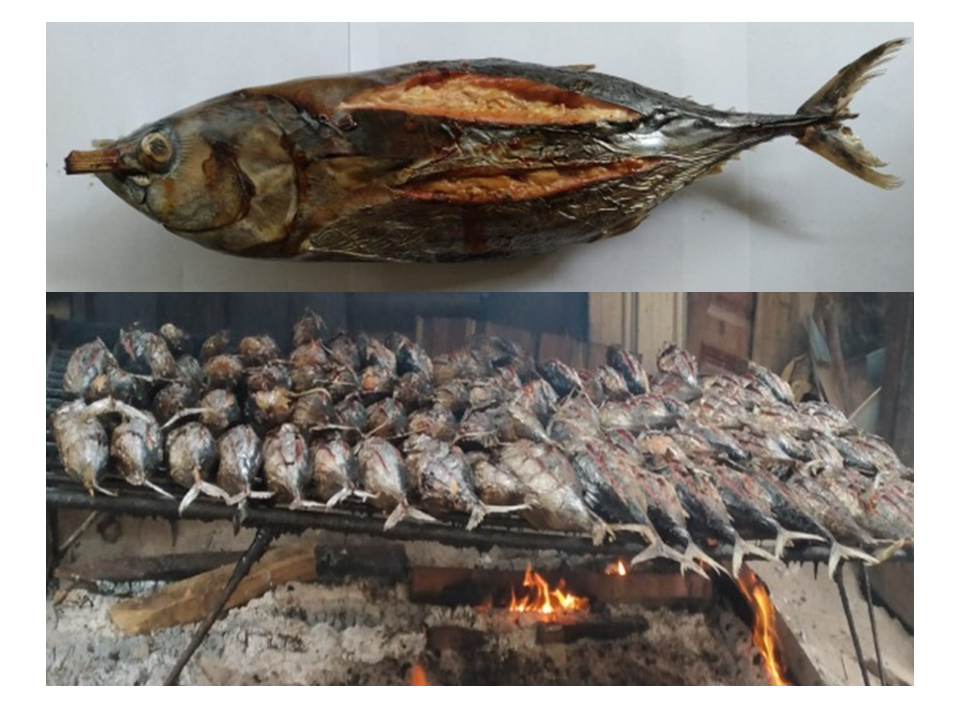Identification of Bacteria in Smoked Fish Marketed in the Pharaa Market Jayapura Distrik.
DOI:
https://doi.org/10.46252/jsai-fpik-unipa.2022.Vol.6.No.3.244Keywords:
bacteria, identification, Katsuwonus pelamis, smoked fishAbstract
The current need of society for the importance of good quality food has required any food producers, particularly smoked fish to make the food available on the market. The quality and safety requirements of smoked fish have been regulated in the Indonesian National Standard. The possibility of bacterial contamination and other factors causing the quality of smoked fish marketed at Pharaa market, Jayapura Regency is very possible, so this research is necessary. The purpose of the study was to identify the presence of bacteria in smoked fish marketed in the Pharaa market, Jayapura Regency. The method applied is to buy smoked skipjack tuna (Katsuwonus pelamis) which is sold at Pharaa Market, then brought to the laboratory for identification. In addition, the testing for Salmonella sp. and Staphylococcus aureus refers to SNI 2897:2008. The research was conducted for three months, from August to October 2021. The finding reveals that the entire sample of smoked fish marketed at Pharaa market, Jayapura Regency, is still fit for consumption. The results showed that no indication of bacteria Salmonella sp and Staphylococcus aureus on smoked fish. In the meantime, in accordance with the Indonesian National Standard (SNI) 2725:2013, the quality and safety requirements of smoked fish with hot smoking are negative for Salmonella sp. and Staphylococcus aureus is max. 1.0 x 103.
Downloads
References
Ali, N.M., Amra,N., & Hamid, F.A. (2016). Identifikasi Bakteri Escherichia Coli (E.Coli) Dan Vibrio Sp Pada Ikan Asap Di Kota Ternate. Jurnal Keseha-tan, 9(02),48-53.
Ariyanti, T., & Supar. (2018). Problematik Salmonellosis Pada Manusia. Lokakarya Nasional Penyakit Zoonosis. Balai Penelitian Veteriner, Bogor.
Estiasih, T., & Ahmadi, K. (2009). Teknologi Pengolahan Pangan. Bumi Aksara. Jakarta.
Gaman, P.M., & Sherrington, K. B. (1994). Pengantar Ilmu Pangan, Nutrisi dan Mikrobiologi. Gadjah Mada University Press. Yogyakarta.
SNI. (2008). Metode Pengujian Cemaran Mikroba Dalam Daging, Telur dan Susu, Serta Hasil Olahannya.
SNI. (2009). Batas Maksimum Cemaran Mikroba dalam Pangan.
SNI. (2013). Ikan Asap dengan Pengasapan Panas.
Mailoa, M. N., Lokollo, E., Nendissa, D.M., & Harsono, P.I. (2019). Karakteristik Mikrobiologi dan Kimiawi Ikan Tuna Asap. Jurnal Pengolahan Hasil Perikanan Indonesia, 22(1):89-99.
Majid, A., & Majid, N. (2021). Isolasi dan Identifikasi Bakteri Salmo-nella Dan Staphylococcus aureus Pada Ikan Tongkol Asap Yang Disimpan Pada Suhu Dan Lama Penyimpanan Yang Berbeda. CHMK Applied Scientific Journal, 4 (2):63-72.
Ningrum, R. K., Rastina, & Mahdi, A. (2021). Deteksi Cemaran Esche-richia coli pada Ikan Patin Asap (Pangasius sutchi) di Desa Koto Masjid Kabupaten Kampar, Riau. Jurnal Ilmiah Mahasiswa Veteriner (JIMVET), 5(1):62-67. DOI:https://doi.org/10.21157/jim%20vet.v5i1.14664.
Sandra, L., & Juhairiyah, J. (2015). Application Of Sanitation And Hygiene In Freezing Fish Anggoli (Pristipomoides multidens) In Cv. Bee Jay Seafoods Probolinggo East Java. Samakia: Jurnal Ilmu Perikanan, 6(1):36-46.
Sasongko, L.W., Nofreeana, A., & Lasmi,L. (2021). Kajian Mutu Dan Umur Simpan Produk Pengasapan Ikan Tongkol (Euthynnus Affinis) Dengan Aplikasi Asap Cair. MANFISH JOURNAL, 1(03):168-173.
Swastawati, F., Surti, T., Agustini, T.W., & Riyadi, P.H. (2013). Karak-teristik Kualitas Ikan Asap Yang Diproses Menggunakan Metode Dan Jenis Ikan Berbeda. Jurnal Aplikasi Teknologi Pangan.2(3).
Yusmita, Sugireng, & Satriani, S. (2019). Identifikasi Bakteri Patogen pada Ikan Cakalang (Katsuwonus pelamis) Asap di Pasar Tradisional Kota Kendari. Jurnal Medilab Mandala Waluya, 3(2).

Downloads
Published
How to Cite
Issue
Section
License
Copyright (c) 2022 Samuel Jeujanan

This work is licensed under a Creative Commons Attribution-ShareAlike 4.0 International License.


















